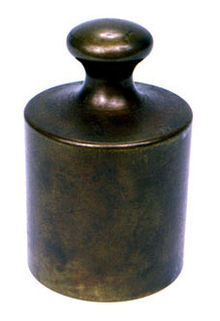Grave (unit)
[4] In 1791, the Commission of Weights and Measures, appointed by the French Academy of Sciences, chose one ten-millionth of the half meridian as the unit of length, and named it metre.
On 7 April 1795, the gram was decreed in France to be "the absolute weight of a volume of pure water equal to the cube of the hundredth part of the metre, and at the temperature of melting ice".
Four new prefixes (deca, hecto, kilo, and myria) were added to the metric system to cover almost the same range of units as in 1793 (milligram, centigram, decigram, gram, decagram, hectogram, kilogram, myriagram).
[Note 2][18] They concluded that one cubic decimetre of water at its maximum density was equal to 99.9265% of the target mass of the provisional kilogram standard made four years earlier.
[19] After the definitions were finalized in 1799, an all-platinum kilogram prototype was fabricated with the objective that it would equal, as close as was scientifically feasible for the day, the mass of one cubic decimetre of water at 4 °C.

